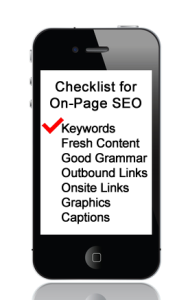
Checklist for On Page Search Engine Optimization (SEO)
Improving your organic search engine results requires on-page optimization. This Checklist for On-Page SEO will help make your web site pages search engine friendly. As online marketing consultants NuZoo Media knows that search engine optimization (SEO) will help the search engines find and spider your site and help you appear higher in the natural, or organic, search engine results.
The On-Page SEO Checklist
- Identify the one or two keyword phrases per page. These keywords should appear in the page name, title, H1 tags, subheads and throughout your content. Use your keyword in the first few sentences, it will help emphasize the page’s topic. And repeat your keyword phrase several times but don’t “stuff” the page with it, the page could be considered spam.
- If you have more than a couple of keyword phrases per page you should create multiple pages so each page is targeted and focused.
- Write high quality, informative content that is at least 300 words in length. There is some debate about how much the length of an article impacts your ranking in Google. Some writers are now leaning towards longer articles. But a good rule of thumb is to write what you have to say, and whether it’s 150 words or 1,500 words as long as it’s relevant to your target audience and topic it’s all good.
- Use well-written articles with good grammar and good spelling! According to Google’s Distinguished Engineer Matt Cutts spelling and grammar do matter.
- Link to relevant content on other web sites. Also known as outbound links, you have control over where you take people, and you should make sure it’s to useful information and related to your own page. On this page I’ve embedded a YouTube link by Google’s Matt Cutts.
- Link to other pages on your site. I add at least one link to other pages on NuZoo’s web site that are relevant to the current article and tie together similar topics.
- Include photos and graphics that help illustrate the content and keyword phrases for that page.
- Add captions for the photos and graphics that include the keyword phrases.
Follow this Checklist for On-Page SEO to make all the pages on your site both user-friendly and search-engine-friendly.